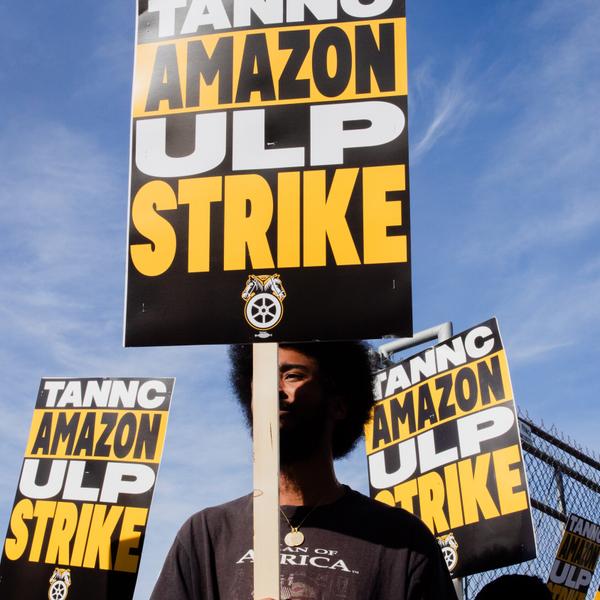
Amazon Workers Strike Back
30 December 2024
On December 18th 2024, Amazon warehouse workers and delivery drivers launched the largest strike in the mega-corporation’s history. The strike hit metro-area locations from San Francisco, Chicago, Atlanta, Southern California, and New York City.
Within a few days the strike had expanded to more locations but came to an end on Christmas Eve without the company agreeing to talks. The strikes came after Amazon refused to meet the Teamsters deadline of December 15th to recognize the unions and agree to collective bargaining.
Amazon is owned by billionaire boss Jeff Bezos. He has almost $240 billion, he makes $3.5 million an hour from the labour of his workforce. Meanwhile Amazon workers would take over 8 weeks work to make what Bezos makes every second.
Workers have already suffered violence and backlash from the cops - the attack dogs of the capitalist state - who are supporting Amazon’s right to exploit people and resources, but not the worker’s right to fight back against low wages in unsafe conditions.
At least one driver was arrested by the NYPD for attempting to block an entrance to a facility in Queens in support of the strike. He was later released but workers present were threatened with mass-arrest.
At the Staten Island facility, videos emerged online of water gushing from a pipe in an area where workers were picketing which, in freezing cold temperatures, presents a severe safety risk at the very least.
Amazon refuses to recognise the drivers as employees but they have immense power - they can shut down Amazon’s entire delivery network.
The unions’ decision to strike now was deliberate. The Christmas season is one of Amazon’s busiest times of the year and is when workers have more leverage. According to Labor Notes:
“Amazon netted 29 percent of all global online orders” during Christmas 2023.
As workers we need to recognize when we have the opportunities to either inflict the most economic damage to the boss’s pockets, or maximize the impact of a strike by drawing attention and support from broader circles.
This had the potential to do both, but ultimately did not lead to significant advances as Amazon was able to mostly ignore the limited strike. Warehouse workers were not called out by unions for the first few days of pickets, even though warehouse workers were the first to unionise.
In many places union officials took over picket duty - rather than pushing workers to join the strike.
The risks associated with Amazon’s brutal, demanding pace of work have been reported on for years. In a report from More Perfect Union in the weeks before the strike, one worker said that “every horror story you read about Amazon is true, but worse,” and that’s why she voted to strike.
It’s a pretty simple formula: increased demand plus increased productivity-targets equals more injuries or potential accidents. With these demands, some workers are forced to do mandatory overtime to fill Amazon orders during peak holiday seasons, which creates a feedback loop of worsening conditions for those making the profits for Jeff Bezos, his senior managers, and shareholders.
It would be negligent not to mention the threat that these levels of production and distribution pose to our climate, and the knock-on effects of climate change related disasters.
Amazon’s competition with bargain and fast fashion companies like Temu and Shein means more orders at cheaper prices with more immediacy for the end consumer. This means constantly expanding production capacity and speed to win more market share and seek out the cheapest labour markets with the least regulation, which drives down wages, worsens safety, and increases the pace of resource extraction and carbon emissions.
Mainstream media, the capitalist propaganda outlets, tried to weaken public support for the strike by saying workers shouldn’t “inconvenience families” during the holidays but we know that it was the boss’s refusal to recognize the unions which caused the strikes to go ahead.
Waiting around for Amazon to talk to trade unions is not a realistic plan, either, so workers are forced to fight back when and where they can.
We know Amazon has no interest in letting unions in to negotiate on behalf of these workers. They have built an entire system of exploitation with obscene profits to destroy any attempt by workers to organise themselves and see ourselves as a class and not just a disparate group of atomised individuals competing against each other.
Labor Notes said:
“Amazon spent more than $17 million on union avoidance consultants” between 2022 and 2023, which demonstrates where their priorities are. And the model of bogus self-employment has given the capitalist class some technical cover when it comes to ordinary labour laws, particularly in the US.
The delivery drivers, for instance, are organised by the Teamsters, the major over-land logistics union which has at times wielded significant worker power. But Amazon does not recognise their drivers, who wear Amazon uniforms, drive Amazon-branded vehicles, and deliver only Amazon products, as Amazon employees.
Rather, they are private contractors or third-party contractors. Across the world we have seen workers in similar scenarios have to fight for their right to be seen as employees just to get the ball rolling on negotiations and workplace protections.
The capitalist state has set up the rules of the game to benefit the bosses, so Amazon has plenty of legal methods of stalling, and deep pockets to wear down the resolve of workers to fight back.
It is easy to be disparaged to see that this strike did not pay off for the workers in any major way. But there are always lessons to be learned.
It will be up to the workers who took the decision to strike to assess their tactics, to look for the benefits of raising awareness across multiple sites and cities and in international headlines.
They also need to look to the future of their fight and get back to organising for more leverage. They need to show workers they can disrupt supply chains and hurt the company. A serious campaign of well organised pickets could bring Amazon to its knees.
The fact that the bosses and the political class that represents them are willing to go to such lengths to stop the workers from being organised and winning better pay and conditions demonstrates this is a fight worth having. They fear the power of the working class and are constantly trying to prevent it from growing.
Workers can also look to the fact that this is a global situation that has workers from California to Germany together in the same fight. Members of unions in Germany joined the strike in Dortmund and Berne. The conditions in Germany (stagnation, mass-layoffs announced, political weakness, etc.) means workers have opportunities to raise class consciousness and lay the groundwork for further struggle and solidarity.
Amazon workers are taking important steps to improve their capacity to fight by working against the conditions that try to destroy solidarity and the power of collective actions. From a distance, it looks like some of those involved are getting a socialist education in addition to essential organising experience.
We can only hope that this political perspective is an integral part of the struggle, so that the working class is not only able to fight and win on limited issues like pay and conditions, but are able to see themselves as part of a political struggle against all those who exploit our class.
Socialist Karl Marx described the development of the working class into a political fighting force in the Manifesto of the Communist Party. His words on trade unions still resonate today as we see workers taking courageous stands across the world against one of capitalism’s most heinous offspring, the Amazon corporation:
“But with the development of industry, the proletariat not only increases in number; it becomes concentrated in greater masses, its strength grows, and it feels that strength more… The increasing improvement of machinery, ever more rapidly developing, makes their livelihood more and more precarious; the collisions between individual workmen and individual bourgeois take more and more the character of collisions between two classes. Thereupon, the workers begin to form combinations (Trade Unions) against the bourgeois; they club together in order to keep up the rate of wages; they found permanent associations in order to make provision beforehand for these occasional revolts…
Now and then the workers are victorious, but only for a time. The real fruit of their battles lies, not in the immediate result, but in the ever expanding union of the workers… It was just this contact that was needed to centralise the numerous local struggles, all of the same character, into one national struggle between classes. But every class struggle is a political struggle…
This organisation of the proletarians into a class, and, consequently into a political party, is continually being upset again by the competition between the workers themselves. But it ever rises up again, stronger, firmer, mightier.
Workers of the world, unite!”
The potential is there to build worker power, to challenge the bosses and take on their puppet state and its cops. But our unions need rank and file workers who are organised to call out timid tactics and challenge union bureaucracts who limit our fight.
We have a world to win.
 RED NETWORK
RED NETWORK